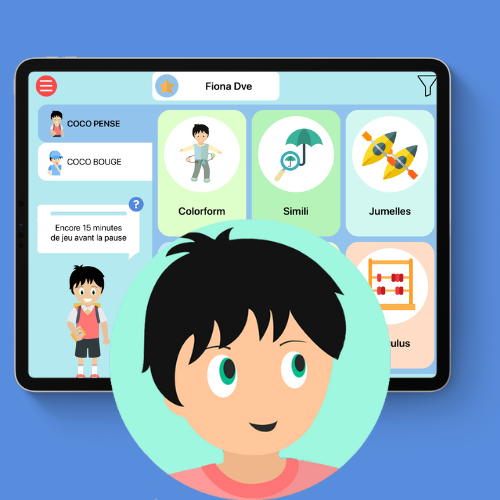What are dyslexia and dyspraxia?
Dyslexia is a learning disability that affects a child’s ability to read, write and understand written language. Dyslexic children may have difficulty recognizing letters, associating sounds with letters and understanding the meaning of words. They may also have difficulty following written instructions and organizing their thoughts coherently.
Dyspraxia, on the other hand, is a motor development disorder that affects the coordination and control of movements. Dyspraxic children may have difficulty performing fine motor tasks, such as tying shoelaces or holding a pencil correctly. They may also have difficulty planning and executing complex movements, such as jumping or cycling.
The effects of dyslexia and dyspraxia on children
Dyslexia and dyspraxia represent major challenges in a child’s educational career and overall development. These conditions, often poorly understood, can seriously affect not only academic performance, but also personal and social development. Here’s an in-depth exploration of the impact of these disorders on children, illustrated by concrete examples and detailed explanations.
Effects on learning and school performance
- Reading and writing difficulties: Dyslexic children can face major obstacles in learning to read and write. These difficulties are reflected in laborious deciphering of words, slow comprehension and hesitant handling of writing. These challenges can hamper their ability to absorb new information and express themselves clearly in writing.
- Problems following written instructions: Following written instructions can be complex for these children. This difficulty results in a constant challenge in the classroom, affecting their understanding of instructions and their ability to complete the required tasks.
- Managing fine motor tasks: Dyspraxic children may face challenges in performing fine motor tasks, such as writing or drawing. This can reduce their ability to manipulate objects with precision, which has a direct impact on their academic performance and participation in creative activities.
Social and emotional impact
- Self-esteem and frustration: Faced with daily obstacles, these children may experience a drop in self-esteem and a growing sense of frustration. The difficulty of keeping up with their peers can make them feel out of step, even isolated.
- Social interaction: The difficulties associated with dyslexia and dyspraxia can also affect social interaction. Children may find it complex to engage in games or sports activities, which can limit their opportunities to forge friendships and feel a sense of belonging to a group.
- Sporting activities: Participation in physical activities and sports can be a major challenge for dyspraxic children. Problems with coordination and movement planning often make these activities less accessible, impacting on their ability to join in team games and enjoy the physical and social benefits of sport.
What we can say is that dyslexia and dyspraxia can significantly influence a child’s developmental trajectory, affecting both academic achievement and emotional and social well-being. Recognizing these challenges and providing appropriate support is crucial to helping these children overcome obstacles and achieve their full potential. This involves a concerted effort on the part of teachers, parents and healthcare professionals to create a caring, inclusive environment that recognizes and values each child’s unique skills.
The importance of emotional support for DYS children
Emotional support is crucial for children with dyslexia and dyspraxia. These conditions can lead to low self-esteem and increased frustration in children, so it’s important that they feel supported and understood.
Parents and caregivers can offer emotional support by encouraging children to express their feelings and validating their experiences. It’s important to recognize that the difficulties they face are not their fault, and that they are not alone in their struggle. Parents can also help children develop positive coping strategies by encouraging them to set realistic goals and celebrating their successes.
How can parents help their DYS children?
The benefits of open and honest communication

At DYNSEO, we’re used to working with families on these issues, and we know from our own experience that open, honest communication provides a solid foundation on which they can build their self-confidence and understanding of their own challenges. Here’s how to deepen this communication and maximize its benefits.
Creating an environment of trust
- Age-appropriate dialogue: It’s crucial to adjust the level of complexity and vocabulary used when explaining dyslexia and dyspraxia. Simple, reassuring explanations can help children understand their situation without feeling overwhelmed or stigmatized.
- Building self-esteem: Discussions should regularly highlight children’s strengths, talents and interests, making it clear that these conditions do not limit their potential. The aim is to cultivate a positive self-image, where difficulties are seen as surmountable obstacles rather than definitive limitations.
Encouraging self-expression
- Questions and concerns: Encourage your child to ask questions and share feelings about his or her experiences. This can be done through informal conversations, moments dedicated to exchange, or even through journals or drawings for children who find it easier to express themselves non-verbally.
- Validating feelings: Recognizing and validating the child’s feelings is fundamental. This means listening without judgment and acknowledging frustrations, fears and successes. Such validation helps to build a sense of emotional security, where children know that their experiences and emotions are taken seriously.
Positive and constructive communication
- Focus on possibilities: It’s beneficial to focus conversations on solutions and coping strategies, rather than problems. This can include discussing creative study techniques, using assistive technologies, or customizing the learning environment to meet the child’s needs.
- Success stories: Sharing stories of individuals who have succeeded despite dyslexia or dyspraxia can be extremely motivating. This shows children that they can achieve their goals and dreams, regardless of the challenges they face.
Collaboration and support
- Involvement in decision-making: Let your child express his or her opinions and take part in decisions about learning strategies and interventions. This reinforces their sense of autonomy and commitment to their own education and personal development.
- Support network: Encourage participation in support groups or activities with other children facing similar challenges. This can help to normalize their experiences, build friendships and reinforce a sense of belonging.
In short, open and honest communication between parents and children about dyslexia and dyspraxia is an empathetic approach that lays a solid foundation for understanding, acceptance and personal growth. By adopting a positive approach, validating children’s experiences, and putting them at the heart of the conversation, families can navigate through challenges together, while celebrating each victory on the road to fulfillment.
How to encourage self-esteem in DYS children?
Encouraging self-esteem in children with dyslexia and dyspraxia is essential. Parents can do this by recognizing and celebrating their children’s successes, both big and small. It’s important to highlight the progress made and the efforts made, rather than focusing solely on results.
Activities that highlight the child’s strengths and interests can also help build self-esteem. For example, if a child is passionate about music, he or she can be encouraged to take part in music lessons or join a choir. This will enable him to develop his skills and self-confidence in an area that is close to his heart.
Strategies to help DYS children learn
There are several specific teaching strategies that can be effective for children with dyslexia and dyspraxia. For example, the use of visual aids such as diagrams or maps can help children better understand the information presented.
It’s also important to adapt teaching to meet children’s specific needs. This can include providing clear, concise instructions, dividing tasks into smaller steps and providing extra time to complete tasks.
How do you manage the emotional challenges of DYS children?
Children with dyslexia and dyspraxia can experience emotional challenges such as frustration, anxiety and depression. It’s important to help these children develop positive coping strategies to deal with these emotions.
Parents can help by encouraging children to express their feelings and providing them with tools for managing stress, such as deep breathing or meditation. It can also be helpful to seek support from a mental health professional, who can help the child develop stress management skills and cope with emotional challenges.
The benefits of therapy for DYS children
Different types of therapy can be useful for children with dyslexia and dyspraxia. For example, occupational therapy can help dyspraxic children improve their fine motor coordination and movement planning. Speech therapy can also benefit dyslexic children, helping them to improve their reading, writing and language comprehension skills.
It’s important to find a qualified therapist with experience in treating children with dyslexia and dyspraxia. Parents can ask their doctor or their child’s school for recommendations, or seek out professionals who specialize in these areas.
How can parents take care of themselves while supporting their DYS children?
It’s vital that parents and carers look after themselves while supporting their children with dyslexia and dyspraxia. Taking care of your own mental and emotional health is crucial to providing effective support for your child.
Parents can take care of themselves by seeking support from other parents in similar situations, engaging in activities that give them pleasure, and taking time to rest and recharge. It can also be helpful to seek support from a mental health professional, who can help parents develop stress management strategies and cope with emotional challenges.
It’s vital that parents and carers understand dyslexia and dyspraxia so that they can offer the necessary support to children with the condition. By providing emotional support, appropriate accommodations and adapted teaching strategies, parents can help their children overcome the challenges associated with these conditions. It’s also important for parents to take care of themselves while supporting their children, so that they can offer effective and lasting support. By seeking resources and support, parents can help their children succeed despite the challenges of dyslexia and dyspraxia.
AND FOR MORE INFORMATION

COCO, CHILDREN’S GAMES DYS
Coco pense et Coco bouge is an educational games program for dyslexic, dyspraxic, dysphasic and dyscalculic children aged 5 to 10. A variety of games to work on all cognitive functions. 15 minutes of screen time = 1 sports break

JOE, FOR DYSLEXIC ADULTS
The JOE program, your brain coach, will be able to support dysfunctional teenagers and adults. They can search for games by cognitive function. Joe will also be able to recommend the games best suited to each user’s needs. Smartphone and tablet.

THE MARBLE THAT ROLLS FOR ATTENTION
The Bille qui Roule application is an innovative tool designed to work on attention and concentration through fun games. The tabletop is used as a pendulum to perform the exercises. For example, you have to follow the ball and keep it in a circle, etc.
Other articles that might interest you:
The Role of Audio Books in the Learning of Dyslexic Children.
Dyslexic children face many difficulties when it comes to reading. The first problem they face is decoding, i.e. the...
Supporting children with autism
Dynseo proposesSUPPORTING CHILDREN WITH AUTISM with COCO THINKS AND COCO MOVESDynseo and its team are very much...
Language and learning disorders: supporting children
How to accompany a child with language and learning disabilities? Children with language disorders have...









